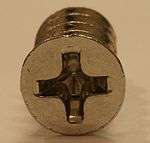Henry F. Phillips

Henry Frank Phillips (June 4, 1889 – April 13, 1958) was a U.S. businessman from Portland, Oregon. The Phillips-head ("crosshead") screw and screwdriver are named after him.[1]
The importance of the crosshead screw design lies in its self-centering property, useful on automated production lines that use powered screwdrivers.[2] Phillips' major contribution was in driving the crosshead concept forward to the point where it was adopted by screwmakers and automobile companies. The credited inventor of the Phillips screw was John P. Thompson.
Biography
After failing to interest manufacturers, Thompson sold his self-centering design to Phillips in 1935.[3] Phillips formed the Phillips Screw Company in 1934. After refining the design himself (U.S. Patent #2,046,343, U.S. Patents #2,046,837 to 2,046,840) for the American Screw Company of Providence, Rhode Island, Phillips succeeded in bringing the design to industrial manufacturing and promoting its rapid adoption as a machine screw standard.[4] One of the first customers was General Motors who used the innovative design in 1936 for its Cadillac assembly-lines. By 1940, 85% of U.S. screw manufacturers had a license for the design.[5] Due to failing health, Phillips retired in 1945. He died in 1958.
References
- ↑ U.S. Patent 2,046,837
- ↑ Adams, Cecil. "Why did this guy Phillips think we needed a new type of screw?". The Straight Dope. Retrieved 9 May 2014.
- ↑ "Phillips Timeline - 1935". Phillips Screw Company. Retrieved 18 November 2011.
- ↑ "Cross Shaped Slots Help Guide Screws" Popular Science, January 1936, page 38 middle of page
- ↑ "About Phillips - A Historic View". Phillips Screw Company. Retrieved 2010-01-11.
